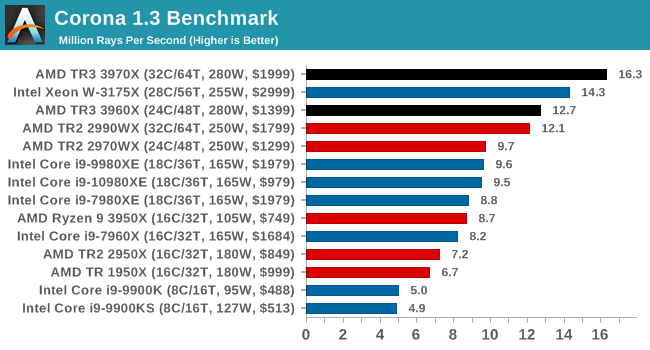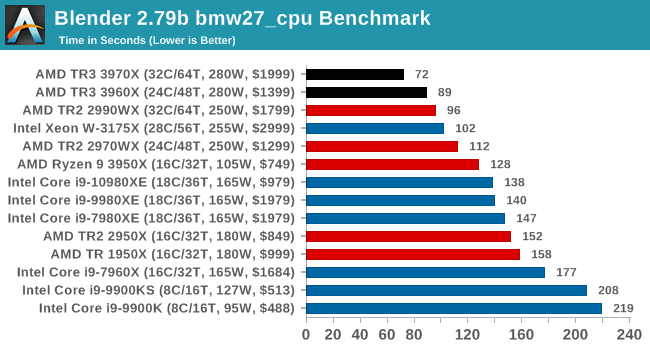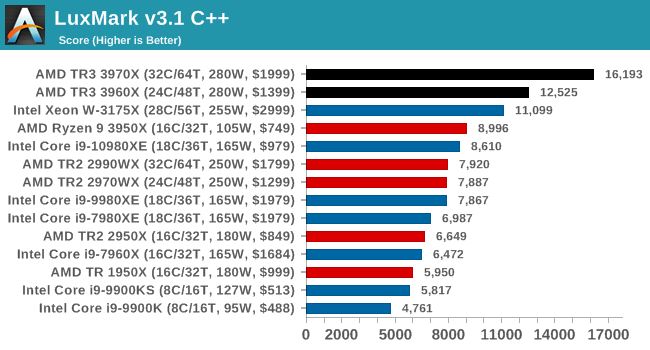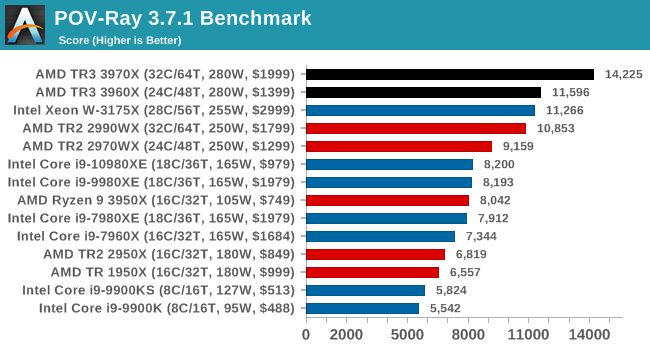The AMD Ryzen Threadripper 3960X and 3970X Review: 24 and 32 Cores on 7nm
by Dr. Ian Cutress, Andrei Frumusanu & Gavin Bonshor on November 25, 2019 9:05 AM ESTCPU Performance: Rendering Tests
Rendering is often a key target for processor workloads, lending itself to a professional environment. It comes in different formats as well, from 3D rendering through rasterization, such as games, or by ray tracing, and invokes the ability of the software to manage meshes, textures, collisions, aliasing, physics (in animations), and discarding unnecessary work. Most renderers offer CPU code paths, while a few use GPUs and select environments use FPGAs or dedicated ASICs. For big studios however, CPUs are still the hardware of choice.
All of our benchmark results can also be found in our benchmark engine, Bench.
Corona 1.3: Performance Render
An advanced performance based renderer for software such as 3ds Max and Cinema 4D, the Corona benchmark renders a generated scene as a standard under its 1.3 software version. Normally the GUI implementation of the benchmark shows the scene being built, and allows the user to upload the result as a ‘time to complete’.
We got in contact with the developer who gave us a command line version of the benchmark that does a direct output of results. Rather than reporting time, we report the average number of rays per second across six runs, as the performance scaling of a result per unit time is typically visually easier to understand.
The Corona benchmark website can be found at https://corona-renderer.com/benchmark

Being fully multithreaded, we see the order here follow core counts. That is except for the 32-core 2990WX sitting behind the 24-core 3960X, which goes to show how much extra performance is in the new TR generation.
Blender 2.79b: 3D Creation Suite
A high profile rendering tool, Blender is open-source allowing for massive amounts of configurability, and is used by a number of high-profile animation studios worldwide. The organization recently released a Blender benchmark package, a couple of weeks after we had narrowed our Blender test for our new suite, however their test can take over an hour. For our results, we run one of the sub-tests in that suite through the command line - a standard ‘bmw27’ scene in CPU only mode, and measure the time to complete the render.
Blender can be downloaded at https://www.blender.org/download/

We have new Threadripper records, with the 3970X almost getting to a minute to compute. Intel's nearest takes almost as long, but does only cost half as much. Again, the 3960X puts the 2990WX in its place.
LuxMark v3.1: LuxRender via Different Code Paths
As stated at the top, there are many different ways to process rendering data: CPU, GPU, Accelerator, and others. On top of that, there are many frameworks and APIs in which to program, depending on how the software will be used. LuxMark, a benchmark developed using the LuxRender engine, offers several different scenes and APIs.
In our test, we run the simple ‘Ball’ scene. This scene starts with a rough render and slowly improves the quality over two minutes, giving a final result in what is essentially an average ‘kilorays per second’.

Our LuxMark test again pushes both TR3 processors out in the lead.
POV-Ray 3.7.1: Ray Tracing
The Persistence of Vision ray tracing engine is another well-known benchmarking tool, which was in a state of relative hibernation until AMD released its Zen processors, to which suddenly both Intel and AMD were submitting code to the main branch of the open source project. For our test, we use the built-in benchmark for all-cores, called from the command line.
POV-Ray can be downloaded from http://www.povray.org/

More rendering, more wins for AMD. More losses for the 2990WX, even though on these tests it still beats the 10980XE quite easily.











245 Comments
View All Comments
mkaibear - Monday, November 25, 2019 - link
Intel had revenue of 19.2bn last quarter. The highest it's ever been for them.https://www.anandtech.com/show/15030/intel-announc...
Claiming that Intel is destroyed is laughable.
They're hurting at the moment, but then they were hurting in the Athlon era as well... and that didn't go so badly for them in the end.
For reference, AMDs revenue for the same period was 1.8bn. yes, Intel, despite all their problems, earned *ten times* what AMD did.
(Reference: https://www.anandtech.com/show/15045/amd-q3-fy-201...
Claiming Intel are destroyed is just fanboyism at its worst.
Xyler94 - Monday, November 25, 2019 - link
Unless Intel can get something out sooner rather than later, people are migrating to AMD because they are pushing things forward. 64 cores of Epyc fury is hitting them in the Server Space, which is where Intel is most scared of. They don't care that you or I buy an Intel chip or an AMD one, they care if Microsoft or Apple buys either or.Intel isn't destroyed, but they will be hurting for a while, as AMD is showing no signs of slowing down, and Intel has to beat what AMD makes next, not AMD today.
mkaibear - Monday, November 25, 2019 - link
Again, Intel have record earnings this last quarter. As in over the last 3 months. As in after two years of AMD kicking their backside in the server space they're still making record amounts of revenue.Intel aren't stupid, they're one of the most ruthless companies in the sector. They can throw five times as much as AMD's *total profit* in R&D and still make five times as much profit as AMD does.
Xyler94 - Monday, November 25, 2019 - link
Record breaking earnings mean nothing in the grand scheme of things.For as much as you gloat about Intel's RND, AMD is the one who's on top in 2 of the 4 markets (Laptops, Desktops, HEDT and Servers), some would argue 3. Doesn't matter how much money you can throw at a problem, it matters if you can solve it. AMD solved the problem, Intel hasn't, and it's a frantic state at Intel to make something happen, either get 10nm working better or changing their uArch in 14nm.
Right now, the only reason to consider a XEON over an Epyc would be for AVX-512 only workloads. Because otherwise, ServerTheHome has shown that Epyc dominates, especially the 7742 64 core part.
SwackandSwalls - Monday, November 25, 2019 - link
Those record breaking earnings (i.e. capital) mean a lot, and saying otherwise displays a large and intentional ignorance on how important capital is to the microprocessor industry. Intel can use that money to hire more both hardware and software talent, fund more research, build more fabs, outspend AMD in marketing, and on and on. If Intel had huge cash reserves but was putting up large losses every quarter then I'd be on board with your "grand scheme of things" comment. In reality they are massively profitable, selling more 14nm chips than they can produce, and have enough cash to not only learn from AMD's successes but also invest in following suit.Xyler94 - Monday, November 25, 2019 - link
Again, Hire all you want, throw as much money as you want. That doesn't matter if there's no results.AMD with literally tenths of Intel's funding can beat them, and have found better ways to make processors to increase core counts without sacrificing efficiency. Intel also needs to spend a lot of money on researching the node itself, AMD doesn't, so not all of Intel's RnD goes to making the CPU, lots of it goes into making the node itself.
So while Intel may make more, they have to spend way more, especially since CPUs aren't the only thing Intel makes (They make flash chips, 3D XPoint, Networking chipsets, and many other products, all vying for that sweet RND cash)
So while Intel makes more, they also spend more. Revenue is a great figure to look at on paper, but it doesn't amount to anything unless the spending is done wisely. AMD surely has shown that it doesn't take Intel levels of cash to become a market leader and capitalize on someone who's grown complacent.
milkywayer - Monday, November 25, 2019 - link
"record breaking numbers mean a lot".So what happened then, why is AMDs offering more power and cost efficient at a much much lower price?
Korguz - Monday, November 25, 2019 - link
mkaibear/SwackandSwalls, and point is ?? intel has all that money, yet.. been milking the SAME architecture for how many years ? as Xyler94 already said.. to keep throwing money at a problem, and it STILL doesnt get fixed, is NOT a good thing. AMD may not have the money that your beloved intel does, but guess what, they have been able to do MORE with what they do have, so tell me who is spending wiser ?? also.. how much of that 19.2 billion has intel had to dump into their fabs??imaheadcase - Monday, November 25, 2019 - link
I really hope you are not comparing Intell vs amd based on a just a CPU..that is illogical.TEAMSWITCHER - Monday, November 25, 2019 - link
Intel isn't "hurting" now... Desktop processors are not what most people want.